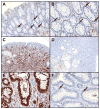Colorectal adenoma stem-like cell populations: associations with adenoma characteristics and metachronous colorectal neoplasia
- PMID: 24008128
- PMCID: PMC4079278
- DOI: 10.1158/1940-6207.CAPR-13-0113
Colorectal adenoma stem-like cell populations: associations with adenoma characteristics and metachronous colorectal neoplasia
Abstract
Cancer stem cells have tumor-initiation and tumor-maintenance capabilities. Stem-like cells are present in colorectal adenomas, but their relationship to adenoma pathology and patient characteristics, including metachronous development of an additional adenoma ("recurrence"), has not been studied extensively. We evaluated the expression of aldehyde dehydrogenase isoform 1A1 (ALDH1A1), a putative stem cell marker, in baseline adenomas from the placebo arm of chemoprevention trial participants with colonoscopic follow-up. An exploratory set of 20 baseline adenomas was analyzed by ALDH1A1 immunohistochemistry with morphometry, and a replication set of 89 adenomas from 76 high-risk participants was evaluated by computerized image analysis. ALDH1A1-labeling indices (ALI) were similar across patient characteristics and in advanced and nonadvanced adenomas. There was a trend toward higher ALIs in adenomas occurring in the right than left colon (P = 0.09). ALIs of synchronous adenomas were correlated (intraclass correlation coefficient 0.67). Participants in both sample sets who developed a metachronous adenoma had significantly higher ALIs in their baseline adenoma than participants who remained adenoma free. In the replication set, the adjusted odds for metachronous adenoma increased 1.46 for each 10% increase in ALIs (P = 0.03). A best-fit algorithm-based cutoff point of 22.4% had specificity of 75.0% and positive predictive value of 70.0% for metachronous adenoma development. A larger population of ALDH1A1-expressing cells in an adenoma is associated with a higher risk for metachronous adenoma, independent of adenoma size or histopathology. If confirmed, ALDH1A1 has potential as a novel biomarker in risk assessment and as a potential stem cell target for chemoprevention.
©2013 AACR
Conflict of interest statement
There are no conflicts of interest the authors wish to disclose.
Figures




References
-
- Brenner H, Chang-Claude J, Rickert A, Seiler CM, Hoffmeister M. Risk of colorectal cancer after detection and removal of adenomas at colonoscopy: population-based case-control study. J Clin Oncol. 2012;30:2969–76. - PubMed
-
- Manser CN, Bachmann LM, Brunner J, Hunold F, Bauerfeind P, Marbet UA. Colonoscopy screening markedly reduces the occurrence of colon carcinomas and carcinoma-related death: a closed cohort study. Gastrointest Endosc. 2012;76:110–7. - PubMed
-
- Lieberman DA, Weiss DG, Harford WV, Ahnen DJ, Provenzale D, Sontag SJ, et al. Five-year colon surveillance after screening colonoscopy. Gastroenterology. 2007;133:1077–85. - PubMed
-
- Winawer SJ, Zauber AG, O’Brien MJ, Ho MN, Gottlieb L, Sternberg SS, et al. Randomized comparison of surveillance intervals after colonoscopic removal of newly diagnosed adenomatous polyps. The National Polyp Study Workgroup. N Engl J Med. 1993;328:901–6. - PubMed
Publication types
MeSH terms
Substances
Grants and funding
LinkOut - more resources
Full Text Sources
Other Literature Sources
Medical
Miscellaneous

